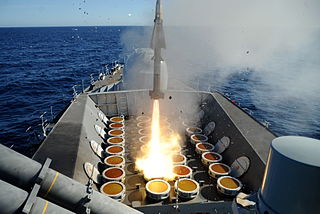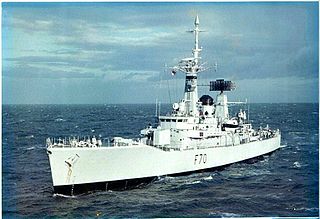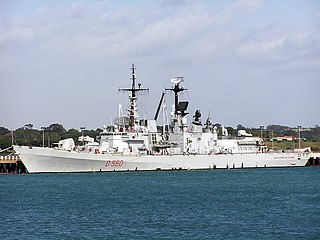
The Type 42 or Sheffield class, was a class of fourteen guided missile destroyers that served in the Royal Navy. A further two ships of this class were built for and served with the Argentine Navy.

The County class was a class of British guided missile destroyers, the first such warships built by the Royal Navy. Designed specifically around the Seaslug anti-aircraft missile system, the primary role of these ships was area air defence around the aircraft carrier task force in the nuclear-war environment.

The Type 21 frigate, or Amazon-class frigate, was a British Royal Navy general-purpose escort that was designed in the late 1960s, built in the 1970s and served throughout the 1980s into the 1990s.

HMS Sheffield was a Type 42 guided missile destroyer and the second Royal Navy ship to be named after the city of Sheffield in Yorkshire. Commissioned on 16 February 1975 the Sheffield was part of the Task Force 317 sent to the Falkland Islands during the Falklands War. She was struck and heavily damaged by an Exocet air-launched anti-ship missile from an Argentine Super Étendard aircraft on 4 May 1982 and foundered while under tow on 10 May 1982.

HMS Glasgow was a Type 42 destroyer of the Royal Navy. The last of the Batch 1 Type 42 destroyers, Glasgow was commissioned in 1979. The destroyer fought during the Falklands War, and on 12 May 1982 was damaged by a bomb from an Argentine A-4 Skyhawk. Glasgow was part of the Royal Navy’s 3rd Destroyer Squadron along with HMS York, HMS Edinburgh and HMS Liverpool. The 3rd Destroyer Squadron was based in Rosyth during the 1980s and early 1990s before being moved to Portsmouth when Rosyth Dockyard was privatised and re-purposed. The destroyer was decommissioned in 2005 and was broken up for scrap in 2009.

HMS Hampshire was a County-class destroyer of the Royal Navy. Laid down, in March 1959 a couple of weeks behind the class leader Devonshire, she was classified as a guided missile destroyer, as the Sea Lords regarded the concept of the cruiser and big gun ship as discredited by the perceived failure of the Tiger class and the obsolescence of the heavy gun. The description of guided missile destroyer seemed more likely to win approval from the Treasury and Government for an adequate number of warships the size of small cruisers, which could play many traditional cruiser flagship and command functions, but had no armour around its gun and missile magazine.

HMS Bristol (D23) was a Type 82 destroyer, the only vessel of her class to be built for the Royal Navy. Bristol was intended to be the first of a class of large destroyers to escort the CVA-01 aircraft carriers projected to come into service in the early 1970s but the rest of the class and the CVA-01 carriers were cancelled as a result of the 1966 Defence White Paper which cut defence spending.

The Daring class was a class of eleven destroyers built for the Royal Navy (RN) and Royal Australian Navy (RAN). Constructed after World War II, and entering service during the 1950s, eight ships were constructed for the RN, and three ships for the RAN. Two of the RN destroyers were subsequently sold to and served in the Peruvian Navy (MGP). A further eight ships were planned for the RN but were cancelled before construction commenced, while a fourth RAN vessel was begun but was cancelled before launch and broken up on the slipway.

The 46 Knox-class frigates were the largest, last, and most numerous of the US Navy's second-generation anti-submarine warfare (ASW) escorts. Originally laid down as ocean escorts, they were all redesignated as frigates on 30 June 1975, in the 1975 ship reclassification plan and their hull designation changed from 'DE' to 'FF'. The Knox class was the Navy's last destroyer-type design with a steam turbine powerplant.

HMS Achilles was a Leander-class frigate of the Royal Navy. She was built by Yarrow at Glasgow. She was launched on 21 November 1968 and commissioned on 9 July 1970. She was sold to Chile in 1991 and served in the Chilean Navy as Ministro Zenteno. She was washed away from her berth at Talcahuano by a tsunami following the February 2010 Chile earthquake, and ran aground on the coast a few kilometres to the north. She was scuttled the following month by the Chilean Navy as a danger to navigation.

Sea Wolf is a naval surface-to-air missile system designed and built by BAC, later to become British Aerospace (BAe) Dynamics, and now MBDA. It is an automated point-defence weapon system designed as a short-range defence against both sea-skimming and high angle anti-ship missiles and aircraft. The Royal Navy has fielded two versions, the GWS-25 Conventionally Launched Sea Wolf (CLSW) and the GWS-26 Vertically Launched Sea Wolf (VLSW) forms. In Royal Navy service Sea Wolf is being replaced by Sea Ceptor.

HMS Cleopatra (F28) was a Leander-class frigate of the Royal Navy (RN). Cleopatra was built at HMNB Devonport. She was launched on 21 March 1964, commissioned on 1 March 1966 and decommissioned on 31 January 1992.

HMS Apollo was a batch 3B broadbeam Leander-class frigate of the Royal Navy. She was, like the rest of the class, named after a figure of mythology. Apollo was built by Yarrow Shipbuilders of Scotstoun. She was launched on 15 October 1970 and commissioned on 28 May 1972, making her the penultimate Leander.

HMS Ariadne was a Leander-class frigate of the Royal Navy. She was launched in 1971, was sold to Chile in 1992 and sunk as a target hulk in 2004.

The Type 82 or Bristol-class destroyer was to have been a class of eight Royal Navy guided missile destroyers mounting the Sea Dart missile, intended to replace the Seaslug-armed County-class destroyers. They would provide area air-defence over carrier task forces and could serve, independently in the a modern cruiser role East of Suez in the Med with significant surveillance, communication, target processing and selection role and long range air, surface and anti submarine missile capability and would also serve in a group of 4/T82 and 4 Broad Beam Leander as outer and inner escorts to the planned CVA-01 aircraft carriers.

Sea Dart, or GWS30. was a Royal Navy surface-to-air missile system designed in the 1960s and entering service in 1973. It was fitted to the Type 42 destroyers, Type 82 destroyer and Invincible-class aircraft carriers of the Royal Navy. Originally developed by Hawker Siddeley, the missile was built by British Aerospace after 1977. It was withdrawn from service in 2012.

The BAe Sea Eagle is a medium weight sea-skimming anti-ship missile designed and built by BAe Dynamics. It is designed to sink or disable ships up to the size of aircraft carriers in the face of jamming and other countermeasures including decoys. Its users include the Royal Air Force and Royal Navy, the Royal Saudi Air Force, and the Indian Navy.
The Type system is a classification system used by the British Royal Navy to classify surface escorts by function. The system evolved in the early 1950s, when the Royal Navy was experimenting with building single-purpose escort vessels with specific roles in light of experience gained in World War II. The original numbering scheme was:

The Durand de la Penne class are two guided missile destroyers operated by the Italian Navy. The design is an enlarged version of the Audace class, updated with diesel and gas turbine CODOG machinery and modern sensors. Four ships were planned but the second pair were cancelled when Italy joined the Horizon project.
The 1981 Defence White Paper was a major review of the United Kingdom's defence policy brought about by the Conservative government under the Prime Minister Margaret Thatcher. The main author was the then Secretary of State for Defence, John Nott. The aim of the review was to reduce expenditure during the early 1980s recession and to focus on supporting NATO rather than out of area operations. It was ultimately judged however to have been extremely detrimental to the Defence of the Realm, being among other things widely considered to have been one of the contributing factors that led to the outbreak of the Falklands War.

















